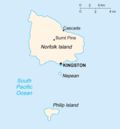Norfolk Island
Norfolk Island is a small island in the Pacific Ocean located between Australia, New Zealand, and New Caledonia. It is part of the Commonwealth of Australia, but it enjoys a large degree of self-governance. Together with two neighbouring islands, it forms one of Australia's external territories.
History[edit]
Norfolk Island was first settled by East Polynesian seafarers either from the Kermadec Islands north of New Zealand or from the North Island of New Zealand. They arrived in the thirteenth or fourteenth century, and survived for several generations before disappearing. The island was subsequently inhabited by the British in 1788, shortly after the establishment of a settlement at Port Jackson. The island was used as a convict penal settlement until May 1855, except for an 11-year hiatus between 1814 and 1825, when it lay abandoned.
Geography[edit]
Norfolk Island is located in the South Pacific Ocean, east of the Australian mainland. It has an area of 34.6 square kilometres, with no land boundaries and 32 kilometres of coastline. The island's highest point is Mount Bates reaching 319 metres above sea level, while its lowest point is the Pacific Ocean. The island's terrain is mainly rolling plains.
Climate[edit]
The island experiences a subtropical climate and temperatures remain fairly constant throughout the year, with average high temperatures ranging from 19 to 25 degrees Celsius.
Demographics[edit]
As of the 2016 Australian census, the population of Norfolk Island was 1,748. The majority of residents are of either Norfolk Islander or Australian descent.
Economy[edit]
The economy of Norfolk Island is largely driven by tourism, which generates around 30% of the island's GDP. Other major sectors include public administration and safety, and education and training.
Government[edit]
Norfolk Island is a territory of Australia and has a multi-tiered system of government that includes a local Legislative Assembly.
Culture[edit]
The culture of Norfolk Island is deeply influenced by its Polynesian and British heritage. The island is known for its distinctive Norfolk language, a blend of 18th-century English and ancient Tahitian.
See also[edit]
Norfolk Island[edit]
-
Norfolk Island jail1
-
Norfolk Island jail
-
Descendants of the mutineers, 1862
-
Norfolk Island Act 1913 Proclamation
-
Norfolk Island Philip Island
-
Norfolk Island CIA WFB Map
-
Government House, Norfolk Island
-
Kermadec Nikau
-
Norfolk Island Gannet chick
-
Norfolk Island masked boobies
Ad. Transform your life with W8MD's Budget GLP-1 injections from $75


W8MD offers a medical weight loss program to lose weight in Philadelphia. Our physician-supervised medical weight loss provides:
- Weight loss injections in NYC (generic and brand names):
- Zepbound / Mounjaro, Wegovy / Ozempic, Saxenda
- Most insurances accepted or discounted self-pay rates. We will obtain insurance prior authorizations if needed.
- Generic GLP1 weight loss injections from $75 for the starting dose.
- Also offer prescription weight loss medications including Phentermine, Qsymia, Diethylpropion, Contrave etc.
NYC weight loss doctor appointmentsNYC weight loss doctor appointments
Start your NYC weight loss journey today at our NYC medical weight loss and Philadelphia medical weight loss clinics.
- Call 718-946-5500 to lose weight in NYC or for medical weight loss in Philadelphia 215-676-2334.
- Tags:NYC medical weight loss, Philadelphia lose weight Zepbound NYC, Budget GLP1 weight loss injections, Wegovy Philadelphia, Wegovy NYC, Philadelphia medical weight loss, Brookly weight loss and Wegovy NYC
|
WikiMD's Wellness Encyclopedia |
| Let Food Be Thy Medicine Medicine Thy Food - Hippocrates |
Medical Disclaimer: WikiMD is not a substitute for professional medical advice. The information on WikiMD is provided as an information resource only, may be incorrect, outdated or misleading, and is not to be used or relied on for any diagnostic or treatment purposes. Please consult your health care provider before making any healthcare decisions or for guidance about a specific medical condition. WikiMD expressly disclaims responsibility, and shall have no liability, for any damages, loss, injury, or liability whatsoever suffered as a result of your reliance on the information contained in this site. By visiting this site you agree to the foregoing terms and conditions, which may from time to time be changed or supplemented by WikiMD. If you do not agree to the foregoing terms and conditions, you should not enter or use this site. See full disclaimer.
Credits:Most images are courtesy of Wikimedia commons, and templates, categories Wikipedia, licensed under CC BY SA or similar.
Translate this page: - East Asian
中文,
日本,
한국어,
South Asian
हिन्दी,
தமிழ்,
తెలుగు,
Urdu,
ಕನ್ನಡ,
Southeast Asian
Indonesian,
Vietnamese,
Thai,
မြန်မာဘာသာ,
বাংলা
European
español,
Deutsch,
français,
Greek,
português do Brasil,
polski,
română,
русский,
Nederlands,
norsk,
svenska,
suomi,
Italian
Middle Eastern & African
عربى,
Turkish,
Persian,
Hebrew,
Afrikaans,
isiZulu,
Kiswahili,
Other
Bulgarian,
Hungarian,
Czech,
Swedish,
മലയാളം,
मराठी,
ਪੰਜਾਬੀ,
ગુજરાતી,
Portuguese,
Ukrainian










